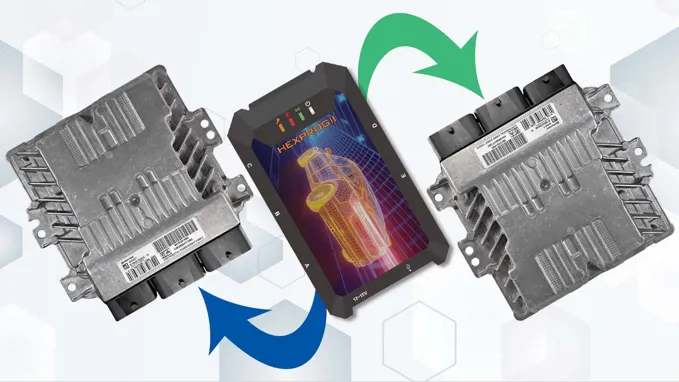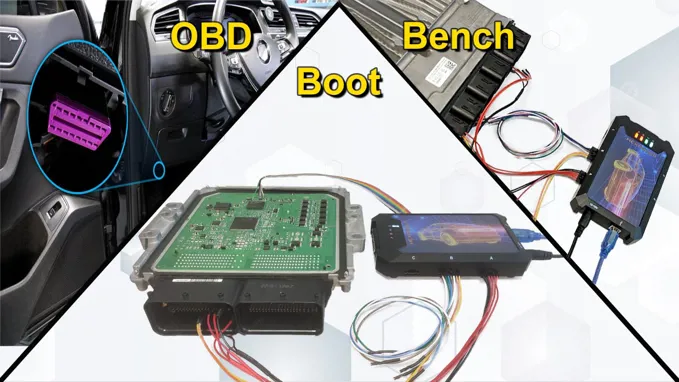Introduction to ECU Cloning
In today’s automotive landscape, Electronic Control Units (ECUs) are integral components that play a crucial role in vehicle performance and functionality. These sophisticated devices manage a wide array of systems within a vehicle, including engine management, transmission control, braking systems, and safety features such as airbags and stability control. Essentially, ECUs are the brains of modern vehicles. Hexprog II Chip Tuning Tool and ECU Programming Tool are specifically designed to enhance the capabilities of these modules. They effectively manage the data processed by various sensors, enabling real-time decision-making that optimizes performance and ensures safety. With Hexprog II, users can easily access and modify ECU settings to achieve improved efficiency and responsiveness.
As vehicles continue to evolve and incorporate more advanced technologies, the complexity of their ECUs has increased significantly. This evolution necessitates that automotive technicians stay updated on these developments and possess the skills required to manage and maintain these systems effectively. One vital skill in this regard is ECU Cloning, which involves creating an exact replica of an ECU's data. Hexprog II Chip Tuning Tool and ECU Programming Tool play a crucial role in this process, allowing technicians to efficiently perform ECU Cloning. By utilizing Hexprog II, technicians can replace or upgrade an ECU without losing critical configurations, settings, or calibration data. This capability not only streamlines repairs but also enhances overall vehicle performance, ensuring that each system operates optimally.
The automotive industry has undergone a profound transformation since the advent of Hexprog II ECU Programming Tool, which has revolutionized automotive engineering. This tool offers a sophisticated and user-friendly solution for managing ECUs, marking a significant advancement in vehicle technology. As automotive technology continues to evolve, there is an increasing demand for precise adjustments and fine-tuning of ECU performance. In today's automotive landscape, where advanced electronics intersect with intricate mechanical systems, Hexprog II Chip Tuning Tool and ECU Programming Tool have become indispensable for automotive technicians, engineers, and enthusiasts alike. These tools empower users to access, adjust, and optimize software parameters within ECUs effectively, ensuring that vehicles perform at their best and adapt to the latest technological advancements.
The evolution of ECU Programming Tool has kept pace with the rapid advancements in automotive technology. Initially, these tools relied on specialized hardware and required expert knowledge, which limited their accessibility. However, the introduction of user-friendly ECU Programming Software has significantly changed the landscape.
Today, Hexprog II tools feature intuitive graphical interfaces that make them accessible to a broader audience, from experienced professional mechanics to enthusiastic car lovers. With Hexprog II Chip Tuning Tool and ECU Programming Tool, users can easily navigate complex ECU systems, allowing for precise adjustments and optimizations that enhance vehicle performance and efficiency. This increased accessibility empowers more individuals to engage with advanced automotive technology, fostering a deeper understanding and appreciation of modern vehicles.
Hexprog II Chip Tuning and ECU Programming Tool has emerged as a leading solution in this area. This innovative tool is specifically designed to meet the intricate demands of the automotive industry, offering advanced capabilities for ECU Programming and ECU Cloning. By utilizing device such Hexprog II, technicians can seamlessly read and back up the data from an existing ECU, ensuring that all necessary parameters are preserved. Once the data is securely stored, it can then be transferred to a new or refurbished ECU, effectively cloning the original unit.
What is ECU Cloning?
ECU Cloning is the process of duplicating the data and configuration of an existing Electronic Control Unit (ECU) to a new or replacement unit. This critical procedure is becoming increasingly important in the automotive industry, particularly as vehicles become more reliant on complex electronic systems. An ECU is responsible for managing various functions within the vehicle, including engine performance, transmission control, fuel efficiency, and even safety features such as anti-lock braking systems and airbag deployment. Given the pivotal role these units play, the ability to clone an ECU can be a game-changer for automotive technicians.
Hexprog II Chip Tuning Tool and ECU Programming Tool offers advanced capabilities for ECU Cloning, providing three distinct functional modes: Bench Mode, Boot Mode, and OBD Mode. Each mode is designed to meet specific needs, ensuring versatility and efficiency in various automotive applications.
Bench Mode allows technicians to connect the ECU directly to a bench setup, providing a controlled environment for reading and writing data. This mode is particularly useful for accessing hard-to-reach ECUs and performing detailed diagnostics.
Boot Mode is designed for more complex operations, enabling the cloning of ECUs that may be locked or require special protocols. This mode is essential for handling a wide range of vehicles and ensuring successful data transfer even in challenging situations.
OBD Mode facilitates on-board diagnostics, allowing for quick and easy access to the ECU through the vehicle's OBD port. This mode is ideal for routine maintenance and quick cloning tasks, making it a favorite among automotive professionals.
In addition to its functional versatility, Hexprog II Chip Tuning Tool and ECU Programming Tool is compatible with multiple vehicle brands, making it a valuable tool for workshops and technicians who work with diverse automotive systems. This broad compatibility ensures that users can efficiently handle various makes and models, streamlining their workflow and enhancing productivity.
Overall, Hexprog II is a comprehensive solution for ECU Cloning, providing the flexibility and capabilities needed to meet the demands of today’s automotive industry.
Essential Reasons for ECU Cloning
Replacement of Faulty ECUs: When an ECU fails, cloning allows a new or refurbished unit to be programmed with the original data, ensuring the vehicle operates as it did before.
Performance Tuning: Cloning enables modifications to the ECU settings for enhanced performance or efficiency without losing the original configuration.
Data Recovery: If an ECU becomes corrupted or damaged, cloning can help recover crucial vehicle data and restore functionality.
Security and Anti-Theft Measures: Cloning can help replace stolen ECUs with one that contains the same configurations and security settings.
Upgrades: As vehicle technology evolves, cloning allows professionals to upgrade ECUs to more advanced versions while retaining original settings and data.
Utilizing Hexprog II Chip Tuning Tool and ECU Programming Tool enhances these cloning capabilities, making the process more efficient and user-friendly for automotive technicians.
Understanding the ECU Cloning Procedure using Hexprog II
ECU Cloning is a key procedure in car repair that allows technicians to create an exact copy of an Electronic Control Unit (ECU). Here’s a simplified step-by-step guide to the ECU Cloning process using Hexprog II Chip Tuning Tool and ECU Programming Tool:
Preparation: Before starting the process, you'll need Hexprog II hardware and Hexprog II ECU Programming Software with valid ECU Cloning license.
Accessing Wiring: Connect ECU on your preferred mode (Bench, Boot, OBD)
Reading Original ECU Data: Once the connection to the ECU is established, read and extract the data from the original ECU. It is possible to read internal and external flash separately in .bin format that can be used for modification and Chip tuning. This data contains essential information about the vehicle's settings, calibration, and configurations
Creating a Backup: The user needs to use the backup button to back up the whole ECU data. After successfully reading the data from the original ECU, backup files are created. This backup file contains all the information required to read and write full data of the ECU accurately. It is essential to store these backup files safely as it serves as the foundation for the cloning process.
Preparing the New ECU: If the goal is to write the ECU onto a new or refurbished one, the new ECU must be prepared. This involves ensuring that the new ECU is compatible with the vehicle and in working condition.
Restoring Data onto New ECU: With the new ECU prepared, the next step is to restore the original backup file onto the new ECU. This process transfers all the original settings and configurations to the new ECU, effectively creating an identical copy of the original. Before restoring the original data, we recommend users to make a backup of new or donor ECU for safety concerns in the future.
Testing and Verification: After the cloning process is complete, it's essential to verify the functionality of the newly cloned ECU. The vehicle should be tested to ensure that all systems are working correctly and that there are no error codes or malfunctions.
Finalization: Once the cloned ECU is verified to be functioning properly, the ECU can be securely reinstalled in the vehicle. It is crucial to ensure that all connections are secure, and that the ECU is properly seated.
Case Study: ECU Cloning in Action
Background
A local shop who owns Hexprog II received a 2019 BMW 3 Series that had experienced a complete ECU failure, resulting in multiple warning lights, and loss of vehicle functionality. The car was essential for the owner, a business professional who relied on it for daily commutes and client meetings.
Objective
The primary goal was to restore the vehicle to its optimal functioning state through ECU cloning with the use of Hexprog II ECU Chip Tuning and ECU Programming Tool, minimizing downtime and maintaining the integrity of the vehicle's features, including its security systems.
Challenges
Complex ECU Systems: The BMW 3 Series has a sophisticated electronic architecture, which includes various ECUs that must communicate seamlessly. Immobilizer Security: The vehicle’s immobilizer system posed a challenge, requiring careful handling to ensure the new ECU would work properly without triggering security faults. Data Integrity: Ensuring all settings, configurations, and codes were accurately transferred to the new ECU was critical for maintaining vehicle performance.
Process
- -Diagnostic Evaluation
- Technicians performed a comprehensive diagnostic assessment to confirm the ECU was the source of the issues. Using Hexprog II, they identified that the original ECU had failed due to a power surge.
- -Data Extraction
- -Connection: The technicians connected to the vehicle’s OBD-II port to access the original ECU data.
- -Reading Data: They successfully extracted all necessary information, including engine parameters, configurations, and immobilizer codes, and saved this data as a backup.
- -ECU Cloning
- -Preparation of New ECU: A compatible replacement ECU was sourced from an authorized supplier.
- -Disabling the Immobilizer: The immobilizer was temporarily disabled using advanced software, allowing for data transfer.
- -Writing Data: The extracted data was written to the new ECU, ensuring that it mirrored the original unit as closely as possible.
- -Verification and Testing
- -Communication Check: After the cloning process, technicians verified that the new ECU communicated effectively with the vehicle’s other systems.
- -Running Diagnostics: A full diagnostic scan was conducted to check for any remaining faults or issues.
- -Test Drive: The vehicle was taken for a test drive to confirm that all features operated correctly, including engine performance, safety systems, and the infotainment unit.
Results
The ECU Cloning process was a success. The vehicle’s performance was restored, with all warning lights extinguished and no further issues reported. The owner was impressed with the quick turnaround and relieved to have their vehicle back in optimal condition.
Benefits of ECU Cloning in This Case
- Cost-Effective Solution: Cloning provided a more affordable alternative to purchasing a brand-new ECU.
- Minimized Downtime: The process was completed swiftly, allowing the owner to return to their daily routine without prolonged disruption.
- Data Integrity Maintained: The cloning preserved all original settings and configurations, ensuring that the vehicle’s performance was consistent with its pre-failure state.
Adaptability to Advanced Technologies: As automotive technology evolves; ECU Cloning becomes increasingly relevant. It supports the integration of new features and systems while preserving the integrity of existing configurations, ensuring compatibility with advanced electronic systems.
Increased Vehicle Longevity: By enabling timely repairs and upgrades through cloning, vehicle owners can extend the life of their cars. Maintaining optimal ECU functionality helps prevent further issues and contributes to overall vehicle reliability.
Using Hexprog II Chip Tuning Tool and ECU Programming Tool amplifies these benefits by streamlining the cloning process. These advanced tools provide technicians with intuitive interfaces and powerful functionalities, enabling them to perform precise adjustments and modifications with ease. Hexprog II allows for quick access to ECU data, facilitating efficient cloning while ensuring that all original configurations and settings are accurately replicated. This enhances the technician's ability to optimize vehicle performance effectively, adapt to new technologies, and deliver a seamless experience for the vehicle owner. With Hexprog II, automotive professionals can ensure that each vehicle maintains its integrity and functionality, even as advancements in automotive technology continue to evolve.




